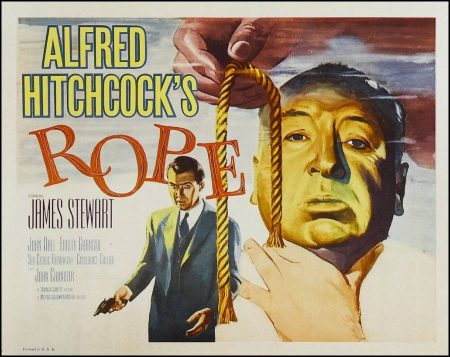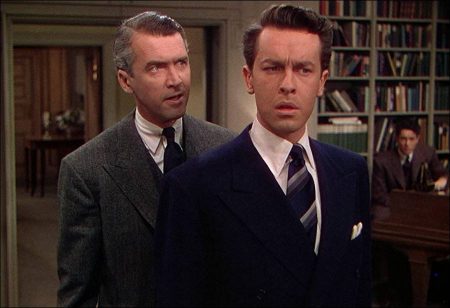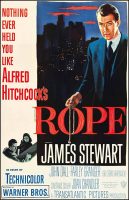Taglines: The guest who’s dead on time.
Rope movie storyline. Manhattan socialites Brandon Shaw and Phillip Morgan choke the life out of an associate, David, as an intellectual challenge to commit the perfect murder. Not content to escape the penalty of law by simply disposing of the body quietly, they furthermore devise an elaborate and dangerous display of arrogance: The two stuff David’s lifeless body into a chest and throw a dinner party serving their guests, literally, from the convenient tabletop of the young man’s grave.
In attendance are Mr. Henry Kentley and Mrs. Anita Atwater, the victim’s father and aunt; Kenneth Turner, the victim’s rival for the hand of Janet Walker, David’s fiancée, who also attends; Mrs. Wilson, the servant; and Rupert Cadell, the murderers’ former teacher whose flippant repartee regarding social caste festered into the pathological short circuit that led to Brandon’s and Phillip’s crime.
Brandon’s sense of intellectual superiority swells to reckless levels throughout the evening as he makes a nail-biting game out of cleverly dropping his guests hints at nasty goings on. Meanwhile, Phillip grows increasingly frightful and guilt-ridden as Rupert inches ever closer to discovering why David hasn’t yet arrived at the party.
Rope is a 1948 American psychological crime thriller film directed by Alfred Hitchcock, based on the 1929 play of the same name by Patrick Hamilton. The film was adapted by Hume Cronyn with a screenplay by Arthur Laurents.
About the Production
The film was produced by Hitchcock and Sidney Bernstein as the first of their Transatlantic Pictures productions. Starring James Stewart, John Dall and Farley Granger, this is the first of Hitchcock’s Technicolor films, and is notable for taking place in real time and being edited so as to appear as a single shot through the use of long takes.
It is the second of Hitchcock’s “limited setting” films, the first being Lifeboat. The original play was said to be inspired by the real-life murder of 14-year-old Bobby Franks in 1924 by University of Chicago students Nathan Leopold and Richard Loeb.
The film is one of Hitchcock’s most experimental and “one of the most interesting experiments ever attempted by a major director working with big box-office names”, abandoning many standard film techniques to allow for the long unbroken scenes. Each shot ran continuously for up to ten minutes (the camera’s film capacity) without interruption. It was shot on a single set, aside from the opening establishing shot street scene under the credits. Camera moves were carefully planned and there was almost no editing.
The walls of the set were on rollers and could silently be moved out of the way to make way for the camera and then replaced when they were to come back into shot. Prop men constantly had to move the furniture and other props out of the way of the large Technicolor camera, and then ensure they were replaced in the correct location. A team of soundmen and camera operators kept the camera and microphones in constant motion, as the actors kept to a carefully choreographed set of cues.
This filming technique, which conveys the impression of continuous action, also serves to lengthen the duration of the action in the mind of the viewer. In a 2002 article in Scientific American, Antonio Damasio argues that the time frame covered by the movie, which lasts 80 minutes and is supposed to be in “real time”, is actually longer—a little more than 100 minutes. This, he states, is accomplished by speeding up the action: the formal dinner lasts only 20 minutes, the sun sets too quickly, and so on.
Actor James Stewart found the whole process highly exasperating, saying “The really important thing being rehearsed here is the camera, not the actors!” Much later Stewart said of the film, “It was worth trying – nobody but Hitch would have tried it. But it really didn’t work.”
The cyclorama in the background was the largest backing ever used on a sound stage. It included models of the Empire State and Chrysler buildings. Numerous chimneys smoke, lights come on in buildings, neon signs light up, and the sunset slowly unfolds as the movie progresses. Within the course of the film the clouds—made of spun glass—change position and shape eight times.
Rope (1948)
Directed by: Alfred Hitchcock
Starring: James Stewart, John Dall, Farley Granger, Joan Chandler, Sir Cedric Hardwicke, Constance Collier, Douglas Dick, Edith Evanson
Screenplay by: Arthur Laurents
Production Design by: Fred Ahern
Cinematography by: Joseph A. Valentine, William V. Skall
Film Editing by: William H. Ziegler
Set Decoration by: Howard Bristol, Emile Kuri
Art Direction by: Perry Ferguson
Music by: David Buttolph, Francis Poulenc
MPAA Rating: None.
Distributed by: Warner Bros. Pictures
Release Date: August 26, 1948 (New York City), September 25, 1948 (United States)
Visits: 159



